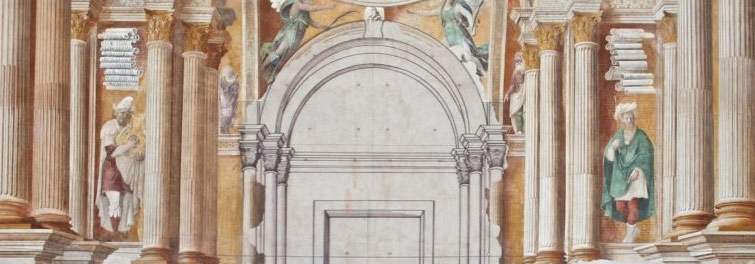And Correggio rediscovers his Last Supper. In San Benedetto Po, an exhibition on the 16th century in the Polirone monastery.
From September 14, 2019 to January 6, 2020, the Basilica and former Monastic Refectory of San Benedetto Po (Mantua) will host the exhibition The Sixteenth Century in Polirone. From Correggio to Giulio Romano. The exhibition, curated by Paolo Bertelli, aims to present the cultural context that animated the monastery of San Benedetto in Polirone in San Benedetto Po in the 16th century. "The renovatio promoted by Giulio Romano within the spaces of the sacred building,“ the presentation reads, ”is located within a broader innovative ferment that, over the course of the century, saw the intervention of Correggio, the sculptor Antonio Begarelli, Fermo Ghisoni and other artisans who gave the complex a modern look."
The Polyronian refectory preserves a famous early fresco by Correggio (Antonio Allegri; Correggio, c. 1489 - 1534), apainted architecture, created between 1513 and 1514 by a then little more than 20-year-old Antonio Allegri, which was intended to house aLast Supper (an interpretation of Leonardo da Vinci’s famous wall painting) painted in 1514 by the Venetian Girolamo Bonsignori (Verona, 1472 - Mantua, 1529). The work was installed in the refectory and remained there for almost three hundred years: then, as a result of Napoleonic spoliations, it was removed from the monastery and is now kept at the Baruffaldi Museum in Badia Polesine after having gone through various vicissitudes (in France it passed from owner to owner, until its return to Italy, precisely in Badia Polesine, in 1927). It is precisely Bonsignori’s LastSupper that is one of the featured works in the exhibition: it will in fact temporarily return to its place of origin to reunite with Correggio’s painted architecture. The work, of imposing dimensions (it is more than seven meters wide) was moved in recent hours, with difficult operations that even involved the demolition of a wall.
The exhibition will also display altarpieces, paintings, period documents, sculptures, illuminated manuscripts, drawings, liturgical vestments and textiles from the 15th and 16th centuries. Opening the exhibition is a portrait by Giulio Romano, which is flanked in the same room by a drawing by Federico Zuccari and a number of altarpieces that belong to the basilica’s 16th-century furnishings. Here, Giulio Romano had signed, a few years before his death, a contract for the creation of the various altarpieces, which were, for the most part, made by Fermo Ghisoni. The itinerary then continues with Correggio, who was present in Polirone in 1514 to sign a contract for the realization of the ante and podium of the organ. To contextualize Bonsignori’s LastSupper, there will also be a large Last Supper by Lorenzo Costa the Younger, formerly inside the Polirone Refectory, and some drawings by Giulio Romano (such as the preparatory sketch for one of the octagons of the Loggia of David in Palazzo Te). This is followed by sixteenth-century paintings, especially those of the Venetian school: a Christ Light of the World by Paris Bordon, an eighteenth-century copy of one of Paolo Veronese’s altarpieces (also victims of Napoleon’s despoliation), a Madonna and Child by Paolo Farinati, a sculpture by Antonio Begarelli present as a cross-reference to Begarelli’s important sculptural corpus preserved inside the basilica, and four sixteenth-century illuminated codices from the Polyronian library.
Closing the itinerary in the refectory is a famous engraving by Alberto Ronco depicting the Benedictine tree. Although already 17th-century, the engraving is valuable in that it shows the facade of the basilica designed by Giulio Romano, which visitors can see as they leave the refectory and enter the church. The basilica still preserves many 16th-century works of art: architecture, decorations, altarpieces. The last section of the exhibition, the liturgical section, is set up in the sacristy with a display of ancient and precious vestments (found during a recent reconnaissance and dating back to the 15th and 16th centuries), accompanied by the original 16th-century candlesticks and cartegloria and a reproduction of the ancient altarpiece of the high altar, now preserved in the Louvre.
The Museo Civico Polironiano opens, in summertime, Tuesday through Friday from 9 a.m. to noon and 3 p.m. to 6 p.m., Saturdays, Sundays and holidays from 9:30 a.m. to 12:30 p.m. and 3 p.m. to 6 p.m. In wintertime, Tuesday through Friday from 9 a.m. to noon and 2:30 p.m. to 5:30 p.m., Saturdays, Sundays and holidays from 9:30 a.m. to 12:30 p.m. and 2:30 p.m. to 5:30 p.m. Closed on Mondays, December 25 and January 1. Tickets (including visit to the basilica): 8 euros full, 7 euros reduced, 5 euros reduced for schools. Museum visit only: 5 euros full, 4 euros reduced. Special family ticket: for each adult, one child free up to 17 years old. For info you can visit the website of the Polironiano Civic Museum of San Benedetto Po.
The exhibition, which contributes to the celebration of the year dedicated to Giulio Romano (culminating with the major exhibition in Mantua opening in October), is the result of the collaboration of the Municipality of San Benedetto Po, the Parish of San Benedetto Po and the Friends of the Basilica of San Benedetto Po Onlus, with the support of the Diocese of Mantua and the Ducal Palace Museum Complex of Mantua.
Pictured: a detail of the architecture painted by Correggio. Ph. Credit Carlo Perini
 |
| And Correggio rediscovers his Last Supper. In San Benedetto Po, an exhibition on the 16th century in the Polirone monastery. |
Warning: the translation into English of the original Italian article was created using automatic tools. We undertake to review all articles, but we do not guarantee the total absence of inaccuracies in the translation due to the program. You can find the original by clicking on the ITA button. If you find any mistake,please contact us.



























